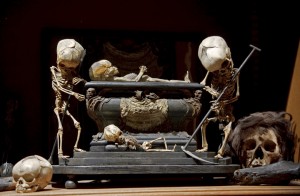 Fetal Skeleton Tableau, 17th Century, University Backroom, Paris; From The Secret Museum. © Joanna Ebenstein, 2010 A heavily illustrated lecture by Morbid Anatomy founder Joanna Ebenstein, followed by afterparty featuring thematic music and specialty cocktails by Friese Undine
Date: Friday, July 13 (Friday the 13th!)
Time: 8:00
Admission: $12
Presented by Morbid Anatomy
Since 2005, artist, independent scholar and Morbid Anatomist Joanna Ebenstein has travelled the world seeking out-and photographing whenever possible-the most fascinating, curious, and overlooked medical collections and wunderkammern, backstage and front, private and public. In the process, she has amassed not only an astounding collection of images but also a great deal of knowledge about the history and cultural context of these fascinating and uncanny artifacts.
This Friday the Thirteenth, please join us for a heavily illustrated lecture based on this research, followed by a thematic afterparty. In her lecture “Anatomical Venuses, The Slashed Beauty, and Fetuses Dancing a Jig,” Ebenstein will lead you on a highly-illustrated tour of medical museums and introduce you to many of their most curious and enigmatic denizens, including the Anatomical Venus, the Slashed Beauty, the allegorical fetal skeleton tableau (as seen above), the flayed horseman of the apocalypse, and three fetuses dancing a jig. Ebenstein will contextualize these artifacts via a discussion of the history of medical museums and modeling, a survey of great artists of the genre, and an examination of other death-related arts and amusements which made up the cultural landscape at the time that these objects were originally created, collected, and exhibited. Following, please stick around for an afterparty featuring thematic tunes and inventive artisanal cocktails complements of the omni-talented Friese Undine.
Joanna Ebenstein is a multi-disciplinary artist with an academic background in intellectual history. She runs the Morbid Anatomy blog and related open-to-the-public Brooklyn-based Morbid Anatomy Library. She is also the founding member of Observatory, a Brooklyn based arts and events space devoted to the revival of the 18th century notions of the dilettante and rational amusements. Her recent work—which includes photography, curation, installation, blogging, museum consulting, lecturing and writing—centers on anatomical museums and their artifacts, collectors and collecting, curiosities and marvels, 18th and 19th Century natural history and, as the subtitle of her blog states, “surveying the interstices of art and medicine, death and culture.” She has lectured at a variety of popular and academic venues, and her work has been shown and published internationally; she is the current Coney Island Musuem artist in resident, and recent solo exhibitions include The Secret Museum and Anatomical Theatre. You can find out more at her at her website astropop.com and her blog Morbid Anatomy; you can view much of her photography work by clicking here. She can be reached at morbidanatomy [at] gmail.com.
 "Field Urchin," 2011, by Saul Chernick; drawn from a series of studies in which he attempted to impose the proportions of cherubs onto horses. A 4-part class with Artist Saul Chernick, M.F.A., Rutgers University
Dates: Mondays June 25, July 2, July 9 & July 16th (4 consecutive Mondays)
Time: 6:30-9:00 PM
Class Fee: $120
***Class size limited to 15; Must RSVP to morbidanatomy [at] gmail.com
This class is part of The Morbid Anatomy Art Academy
Contemporary artist and arts educator Saul Chernick is renowned for gorgeous artworks featuring convincingly corporeal depictions of imaginary or mythical creatures rendered in the style of Medieval and early Renaissance woodcuts from Northern Europe. Observatory is very pleased to announce a new workshop developed by Saul Chernick specially for the Morbid Anatomy Art Academy. In this class, Chernick will teach students-via illustrated lectures and in-class projects including paper puppets and bestiary pages-”to use observational and imaginative drawing skills in tandem to capture the essential qualities of their subject” and “learn to draw animals (real, mythic, and otherwise) with greater skill and sensitivity.”
Full class description follows; you can see more of Chernick’s fantastic work by clicking here. Class size limited to 15; Please RSVP to morbidanatomy [at] gmail.com.
Course Description
Open to artists of all levels, the goal of this workshop is help participants learn to draw animals (real, mythic, and otherwise) with greater skill and sensitivity. Through exercises in drawing and paper puppetry, participants will gain a deeper understanding of the skeletal/muscular structures of most mammals, reptiles, and birds. Participants will also learn to use observational and imaginative drawing skills in tandem to capture the essential qualities of their subject and create works of convincing visual fiction!
What to expect
- Participants will cull images from the web to create a dossier on the animal(s) that interest them
- Participants will fashion movable paper puppets to understand how their chosen animal moves
- Participants will draw studies of the skeletal and muscular structures of animals
- Participants will use the medium of their choice to create a Bestiary page entry that depicts an animal situated in an environment
Materials
What to bring to the first class:
- Choose 1-3 animals and gather pictures on the web. Be sure to get images of their skeletons in profile. Please print these as they may be hard to use on a phone screen.
- 3-5 sheets of Bristol Board Paper 9″ x 12″ or larger
- Pencils & erasers
- Scissors
- Xacto or utility knife
- Glue
What to bring for subsequent classes:
- White or tinted drawing paper 16″ x 20″ or 18″ x 24″
- Tracing paper (same size as drawing paper)
- Mechanical and/or regular pencils (2h, hb, 2b, 4b)
Optional:
- Markers, watercolors, gouache, ink, brushes, chalk/oil pastels, colored pencils, Caran D’Ache, collage papers, etc (we’ll discuss further in detail!)
Saul Chernick, M.F.A., Rutgers University, is a visual artist and educator. Chernick has exhibited internationally in galleries and museums including the Aldrich Museum of Contemporary Art, the Bronx Museum of Art, the Jewish Museum of Art, as well as Max Protetch and Meulensteen Galleries in New York City. He has taught art for the public school system, the 92nd Street Y, Cooper Union, Parson’s School of Design, and the Museum of Modern Art. He is currently the Professional Development Coordinator for the Joan Mitchell Foundation where he coaches New York artists in teaching art to young people throughout city. His work can be seen at www.saulchernick.com.
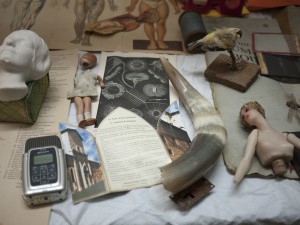 Post-deluge view of the Morbid Anatomy Library Collection Benefit Party to Rebuild The Morbid Anatomy Library
Date: Saturday, June 30
Time: 8:00
Admission: TBD
Presented by Morbid Anatomy
On Good Friday, 2012, The Morbid Anatomy Library suffered a deluge; a fire in an upstairs gallery set off the sprinkler system, dousing the library below and destroying many books and artifacts.
On Saturday, May 12th, come join Observatory and The Morbid Anatomy Library for a star-studded resurrection spectacular featuring Evan Michelson of TV’s “Oddities,” cult writer and luminary Mark Dery, our friends at The Midnight Archive, Absinthe compliments of Le Fée, music from The Thigh Highs, and artful gifts from Kikkerland. There will be also be a scintillating silent auction of taxidermy, artworks, specimens and ephemera, music from the Thigh Highs, and much, much more.
Details to follow; for now please save the date, and stay tuned!
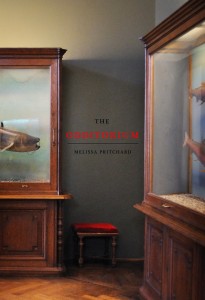 Illustrated lecture and booksigning with Melissa Pritchard, author of The Odditorium Illustrated lecture and booksigning with Melissa Pritchard, author of The Odditorium
Date: Monday, May 7
Time: 8:00
Admission: $5
Presented by Morbid Anatomy
Tonight, please join-Melissa Pritchard, award winning fiction writer, essayist and journalist-for an illustrated lecture on some of the more extreme and unusual historical personalities and architectures featured in her highly praised new collection of stories, The Odditorium. From the enigma of the German feral child, Kaspar Hauser, to St. Pelagia, Russian “holy fool,” to Robert Ripley of Believe it or Not fame and the Wild West Show’s sharpshooter Annie Oakley, Pritchard will discuss her own fascination with the bizarre, the haunted, the fantastic and the grotesque, including short excerpts from several stories while asking of herself and her audience the bigger question: What lies behind our cultural obsession with extremes, from the tragic to the sublime, from the monstrous to the transcendent?
Melissa Pritchard is a Flannery O’Connor, Janet Heidinger Kafka, and Carl Sandburg Award-winning author. She has also been an embedded journalist in Afghanistan, where she befriended Ashton Goodman, a young soldier she memorialized for O, The Oprah Magazine, and authored a biography of Virginia Galvin Piper that US Supreme Court Justice Sandra Day O’ Connor called “a delight to read.” Founder of the Ashton Goodman Fund and a member of the Afghan Women’s Writing Project, helping to promote literacy and education for Afghan women and girls, she teaches at Arizona State University.
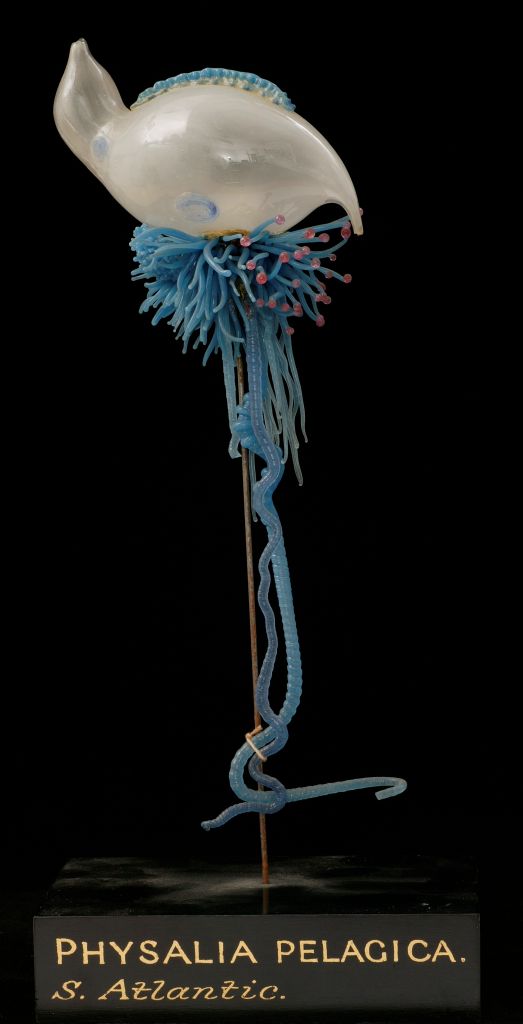 © The Natural History Museum, London 2012. All Rights Reserved. Illustrated lecture with Miranda Lowe, The Natural History Museum (NHM), London Curator
Date: Thursday, May 10
Time: 8:00
Admission: $8
Presented by Morbid Anatomy
Although more famously know for the making the glass flowers exhibited at the Harvard Museum of Natural History, the father and son partnership of Leopold (1822-1895) and Rudolf (1857-1939) Blaschka also made numerous marine invertebrate glass models. Some of the first models they made were sea anemones in the early 1860’s. The Natural History Museum (NHM), London purchased their first set around 1865 and holds over 185 Blaschka glass models consisting of anemones, sea slugs, jellyfish, octopus, squid, protozoans and corals representing their entire model making career. The models were made in a variety ways with many formed over wire skeletons (known as armatures) with the glass fused together or glued. Profiled in various scientific sales catalogues such as Henry A. Ward’s they were to sold museums, universities and private collectors by the Blaschkas themselves and various agents who worked on their behalf worldwide. In the past these models were of scientific importance in teaching but as trends change their significance as works of art are also being highlighted. Each glass model is a unique blend of art, science and craftsmanship looking more life-like than real specimens whose natural colours may fade when stored in jars of preservation fluid over time. This highly illustrated lecture will give a fascinating insight to this collection housed at one of the major natural history museums in the world.
Miranda Lowe is the Collections Manager of the Marine Invertebrates Division, Zoology Department, The Natural History Museum (NHM), London. Within Zoology Miranda specifically manages the Crustacea collections as well as the team of curators responsible for the Invertebrate collections. Darwin barnacles and the Blaschka marine invertebrate glass models are amongst some of the historical collections that are her interests and under her care. In 2006, she was part of the organising committee and invited speaker at the 1st international Blaschka congress held in Dublin. Miranda collaborated with the National Glass Centre, Sunderland, UK in 2008 to exhibit some of the Museum’s Blaschka collection alongside contemporary Blaschka inspired art. She also has an interest in photography, natural history - past and present serving on a number of committees including the Society for the History of Natural History (SHNH) and the Natural Sciences Association (NatSCA).
 An early blood transfusion from lamb to man, ca 1705. From "Tryals Proposed by Mr. Boyle to Dr. Lower, to be Made by Him, for the Improvement of Transfusing Blood out of One Live Animal into Another," Mr. Boyle Illustrated lecture with Paul Craddock
Date: Monday, May 14
Time: 8:00
Admission: $5
Presented by Morbid Anatomy
Those living in Britain (who owned a television set) about ten years ago might remember Sean Bean before he became a famous movie star. Apart from his appearance in Sharpe, he starred in a television advertisement for the National Blood Foundation, prompting people in his thick Yorkshire accent to ‘do something amazing today’; ’save a life’ by giving blood. The foundation’s message is still the same, though Sean Bean has moved onto other projects such as Lord of the Rings. In any case, this illustrated lecture is about just that: the transfusion of blood and its many meanings. But it focuses on a much earlier (and stranger) period of transfusion history when saving a life was only one reason to transfuse blood - from the sixteenth century to the nineteenth.
The association between blood and life is a very easy one to make and seems to span all cultures and time periods, as does the very idea of swapping blood from one person to another. But what it means to swap one being’s blood with another’s - and why this might be attempted - has radically changed. It is only very recently, (around the turn of the twentieth century), that blood was transfused in order to purposefully replace lost blood. For the majority of this history, this was most certainly not the case. In the seventeenth century, transfusions of lamb’s blood were made to calm mad patients and, in the nineteenth century, blood was transfused in order to restore a portion of an invisible living principle living inside of it. This lecture explores from where these ideas came and the ways in which bits of them might linger in our own ideas of transfusion.
On one last note: Paul Craddock commissioned a medical instrument maker to produce some early nineteenth century transfusion equipment. He hopes to demonstrate them at work if he can get them past customs!
Paul Craddock is currently writing on pre-20th century transplant surgery and transfusion at the London Consortium working under Prof. Steven Connor (University of London) and Prof. Holly Tucker (Vanderbilt University, Nashville). After a brief time studying music and performing arts, living in rural China, and working for the National Health Service, Paul made the switch to cultural and medical history. He has never had a transplant and never received a transfusion - his interest in these procedures come from thinking about generally how we relate to the material world by making bodily transactions. He has lectured around the UK and Europe, and last year he spoke at the Observatory Gallery on skin grafting.
Currently based in London, Paul is the Director of London Consortium Television, the audio-visual arm of the London Consortium (www.londonconsortium.tv). He is also the Guests’ Secretary for the University of London’s Extra Mural Literature Association. In another professional life, he produces films for medical establishments and museum exhibitions.
 Date: Thursday, April 19th Date: Thursday, April 19th
Time: 7:30 PM
Admission: $7 (0r $75 for admission to all Congress events; more on that here)
***Location: The Coney Island Museum, 1208 Surf Avenue
Part of The 2012 Congress of Curious Peoples
Presented by Morbid Anatomy and The Coney Island Museum
f you like Quack Medical devices from the turn of the century, if cool inventions titillate you, then this is the show for you. The Museum of Interesting Things scoured our collection for the most bizarre, weird, unusual or kooky stuff we could find and put together a show just for the Coney Island Congress of Curious People.
Full lineup and more information on The 2012 Congress of Curious Peoples can be found here.
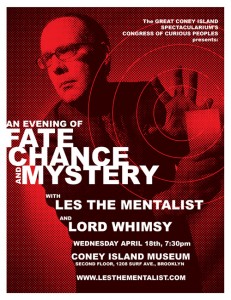 Lecture and performance with Lord Whimsy and Les the Mentalist Lecture and performance with Lord Whimsy and Les the Mentalist
Date: Wednesday, April 18th
Time: 7:30 PM
Admission: $7 (0r $75 for admission to all Congress events; more on that here)
***Location: The Coney Island Museum, 1208 Surf Avenue
Part of The 2012 Congress of Curious Peoples
Presented by Morbid Anatomy and The Coney Island Museum
Lord Whimsy and Les the Mentalist will dazzle our audiences in their virtuosic return to the Coney Island Museum. In this hour-long presentation, they will give a historical overview of the topics of Fate and Chance with a nod to Culture and Folklore, while amazing the crowd with Mentalist effects and a phenomenal display of arcane knowledge.
Lord Whimsy wrote, designed, and illustrated The Affected Provincial’s Companion, Volume One (Bloomsbury 2006), which has been optioned for film by Johnny Depp’s production company, Infinitum Nihil. A devoted enthusiast, lower-case adventurer, and explorer of what he calls “the local frontier,” Whimsy spends most of his time among the nooks and margins of the forgotten, the curious, and the speculative that is found beneath, around, and between the everyday.
Les the Mentalist first amazed the Coney Island audience during last year’s Grand Guignol Variety Show. His magic explores the mysteries of the human mind by exhibiting feats of uncanny cognition, parapsychology and clairvoyance.
Full lineup and more information on The 2012 Congress of Curious Peoples can be found here.
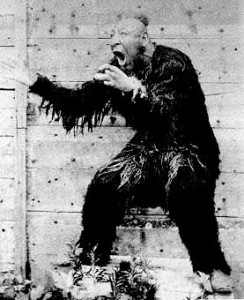 An Illustrated lecture with Philip Kadish An Illustrated lecture with Philip Kadish
Date: Tuesday, April 17th
Time: 7:30 PM
Admission: $7 (0r $75 for admission to all Congress events; more on that here)
***Location: The Coney Island Museum, 1208 Surf Avenue
Part of The 2012 Congress of Curious Peoples
Presented by Morbid Anatomy and The Coney Island Museum
In 1860, showman P.T. Barnum began presenting a number of “pinhead” performers (persons with microcephaly, or unusually small heads) as members of newly discovered races or evolutionary missing links between apes and humans. These “pinhead race” acts were enormously popular as America stood on the brink of civil war over the issue of slavery, and as racial “science” was poised to become the foundational justification of Jim Crow segregation. Unsurprisingly, the most successful of all of these “pinhead race” acts was the “What Is It?”, an African-American microcephalic who became a public sensation, to the point of being used in political cartoons attacking President Abraham Lincoln.” This lecture is structured around a trove of amazing images including photographs, posters, advertisements, political cartoons, news illustrations, and stunningly-offensive scientific charts.
Philip Kadish is completing his PhD in American Literature at the City University of New York Graduate Center. He earned an MFA in fiction writing, and has written about the world of nineteenth century freak shows in fiction as well as scholarship.
Full lineup and more information on The 2012 Congress of Curious Peoples can be found here.
 An illustrated lecture with Amy Herzog, Queens College An illustrated lecture with Amy Herzog, Queens College
Date: Monday, April 16th
Time: 7:30 PM
Admission: $7 (0r $75 for admission to all Congress events; more on that here)
***Location: The Coney Island Museum, 1208 Surf Avenue
Part of The 2012 Congress of Curious Peoples
Presented by Morbid Anatomy and The Coney Island Museum
Amy Herzog returns to the Coney Island USA stage to assess the use of architectural renderings in imagining and promoting new development in 21st century Brooklyn as well as the fabulous and fantastical work of Albert Grass in Coney Island in the 1940’s. Playing with the notion of Brooklyn as a virtual playground she will explore the relationship between immersive experience and architectural fantasy. Those lucky enough to have seen Amy’s lectures in previous Congressional gatherings will know that her performances are not to be missed.
Amy Herzog is a professor of Media Studies at Queens College and the Author of “Dreams of Difference, Songs of the Same: The Musical Moment in Film”.
Full lineup and more information on The 2012 Congress of Curious Peoples can be found here.
|



 Illustrated lecture and booksigning with Melissa Pritchard, author of The Odditorium
Illustrated lecture and booksigning with Melissa Pritchard, author of The Odditorium

 Date: Thursday, April 19th
Date: Thursday, April 19th Lecture and performance with Lord Whimsy and Les the Mentalist
Lecture and performance with Lord Whimsy and Les the Mentalist An Illustrated lecture with Philip Kadish
An Illustrated lecture with Philip Kadish  An illustrated lecture with Amy Herzog, Queens College
An illustrated lecture with Amy Herzog, Queens College